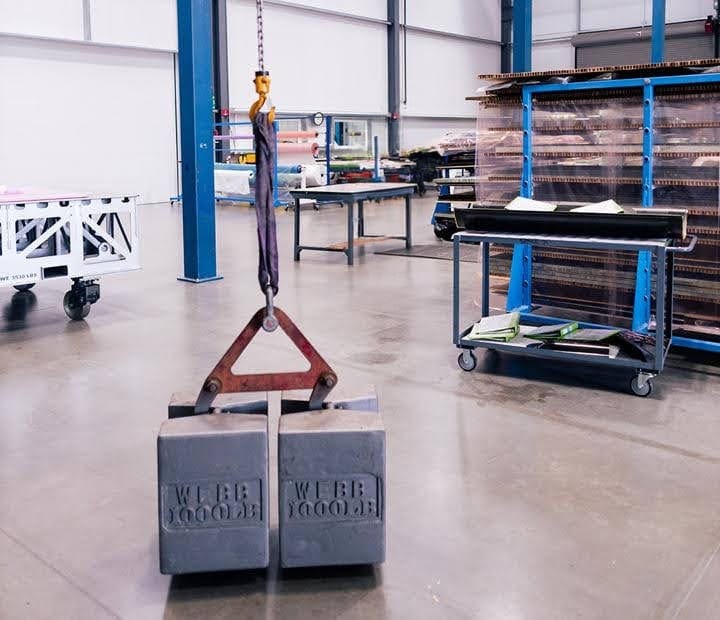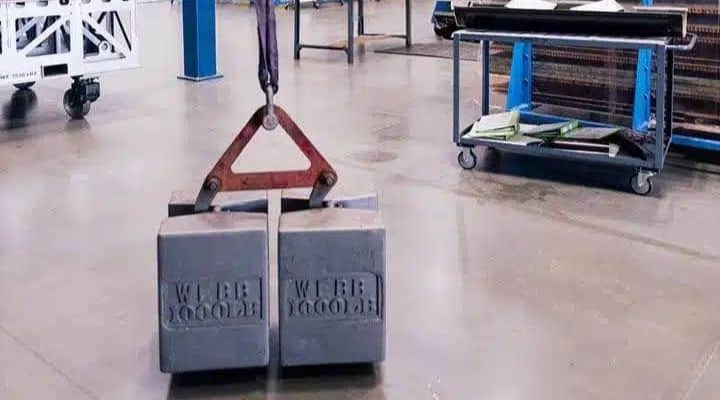When looking at injury statistics, cranes are often cited as being the most dangerous piece of equipment on site. One article states that approximately 80% of crane accidents are a result of operators exceeding the crane’s capacity. Further, the Bureau of Labor Statistics notes that “just over half of all fatal crane injuries involved the worker being struck by an object or equipment. About three-fifths of these cases involved the worker being struck by a falling object or equipment.”
These statistics likely don’t come as a surprise, which is why the Occupational Safety and Health Administration (OSHA) heavily regulates crane inspections to help keep workers safe. One of the inspection requirements imparted by OSHA is crane load testing, which essentially involves temporarily subjecting a crane to a load beyond it’s normal operating limit to validate that it can, in fact, support its rated load (with a factor of safety). This is important, because if a crane’s load limit is indicated as 2 tons but it can only actually safely move 1.5 tons, it’s only a matter of time before disaster strikes.
In this article, we’ll discuss the crane load testing requirements stipulated by OSHA and how crane load tests are typically performed.
Why is crane load testing important?
Crane load testing is important because it helps mitigate accidents and injuries by identifying any functional flaws in a controlled environment. Cranes are regularly relied upon to move large loads in congested areas. Identifying defects, damage, or weak points in a controlled environment is preferable to having a malfunction or failure while moving thousands of pounds over personnel and structures.
Visual examination of a crane only provides a limited amount of information as to its condition. Oftentimes weak or damaged components, especially those in inconspicuous locations on the crane, will become apparent only after the equipment is subjected to extreme loads. When the crane is not under extreme loading, these parts may otherwise function normally.

When is crane load testing required?
Crane load testing requirements are governed by OSHA standard CFR 1910.179 – Overhead and Gantry Cranes. Within this CFR, paragraph 1910.179(b)(2) states that all new overhead and gantry cranes must meet the design specifications set forth in ASME/ANSI B30.2.0-1967, which is incorporated by reference and provides a more detailed explanation of the testing procedures.
OSHA CFR 1910.179 states that “prior to initial use all new and altered cranes shall be tested to insure compliance with this section”. Within ASME/ANSI B30.2.0, there has been some confusion because the standard states that all new, extensively repaired, and altered cranes “should” be tested. However, OSHA clarified in a letter of interpretation dated March 4, 1991, that although crane load testing is only recommended by ANSI, it is required by OSHA.
To summarize,
- New Cranes – Any time you install a new overhead crane, a rated load test is required.
- Altered Cranes – Cranes can be modified and re-rated provided that the supporting structure is checked thoroughly for the new rated load by a qualified engineer or the equipment manufacturer.
What is considered to be an “altered crane” that would trigger a rated load test is somewhat ambiguous in the regulations. In an ASME B30.2.0 interpretation dated December 12, 1995, it is stated that “the determination to load test may be made by anyone who has responsibility over the use of the crane. Such determination is not limited to a designated or authorized person as defined in the standard”. In other words, ASME is deferring to engineering judgement to determine whether a crane alteration is structural in nature and should require load testing. If you are making any alterations to your crane system, you should check with the manufacturer to see whether or not a crane load test is needed for the given alteration.
Crane Load Testing Procedures
The general procedures for crane load testing are outlined in ASME/ANSI B30.2, paragraph 2-2.2.2, “Rated Load Test”. These requirements specify that a crane’s load rating should not be more than 80% of the maximum load that was sustained during the test. The guidelines also state that test loads shall not be more than 125% of the rated load unless recommended by the manufacturer.
As an example, if you want to rate a crane for 1,000 pounds, a load of 1,250 pounds must be supported during the crane load test. You should not test beyond 1,250 pounds unless it is explicitly recommended by the crane manufacturer.
The following activities must be completed (as a minimum) during a crane load test, as defined by ANSI B30.2:
1. Hoist the test load a distance to assure that the load is supported by the crane and held by the hoist brake(s).
2. Transport the test load by means of the trolley for the full length of the bridge.
3. Transport the test load by means of the bridge for the full length of the runway in one direction with the trolley as close to the extreme right-hand end of the crane as practical, and in the other direction with the trolley as close to the extreme left-hand end of the crane as practical.
4. Lower the test load and stop and hold the load with the brake(s).
Various companies offer crane testing services and can bring test weights to your facility for the rated load test. For larger cranes, water weights are often used as a safer alternative to standard weights.
How Do Regulators Ensure That Load Tests Are Performed?
OSHA may make inspections to any worksite, and rarely will advance notice be provided. These inspections may cover the entire workplace or just a few operations. OSHA inspectors are referred to as Compliance Officers, and they may have training on safety hazards, health hazards, or both.
The following are some reasons why OSHA may select a company for inspection, in order of priority:
- Imminent Danger, when there is a good chance that a hazard could result in death or serious harm.
- Fatal or Catastrophic Accidents, all work-related fatalities must be reported within 8 hours, and all work-related inpatient hospitalizations, amputations, or losses of an eye must be reported within 24 hours.
- Employee Complaints of unsafe working conditions or alleged safety violations.
- Program Inspections in industries that have a higher-than-normal accident rate.
- Special Emphasis Programs that are currently being targeted by OSHA, like Excavations, for example.
- Follow-up Inspections to verify that cited violations have been corrected (abated).
We can help keep you with compliance
Crane Tech can handle all forms of crane-related safety inspections, emergency repairs, and upgrades for your business. As seasoned crane technicians, we can also provide your workers with specialized crane-related training courses to improve uptime and productivity. Contact us today for more information on crane load testing and other crane maintenance requirements.




